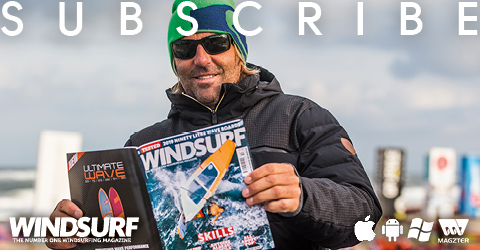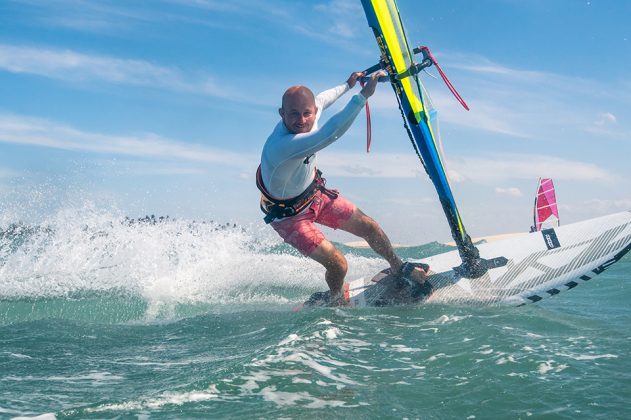JEM HALL
MOVE ON UP – WINDSURFING TECHNIQUE
FOOTLOOSE: GYBING FOOTWORK
This month we look at footwork in the gybe. It is not as complex as you think and specific actions will make you light on your feet and put precision into your gybes. Get this phase right and the nirvana of either your first gybe exit, or even a planing gybe exit, is so much closer! The best news is you can really practice the footwork at slower speeds in light winds and on bigger boards.
With Jem Hall //Photos Nicolas Jones
www.jemhall.com
(This feature originally appeared in the March 2019 issue of Windsurf Magazine. To read more features like this first, Print and Digital subscriptions are available. Prices include delivery globally for 10 x issues a year!)
When I talk gybe, I am talking the ‘step’ style of carve gybe where we change our feet before the rig, as this is the most efficient and versatile gybe and can be done in all winds on all boards. I see all sorts of funky strap and hybrid gybes and these might work to give you a ‘dryish’ gybe but they will never be as efficient or effective as a proper step gybe. As I have said before, the gybe is a thing of beauty, and if it is worth doing it is worth doing well.
As a recap I will go over some general gybe tips and give you the inside line on what light wind moves to master. Lastly I will give you some top tips on the footwork, which runs from mid gybe into the exit phase. The rig rotation and carving out of the gybe will be covered later this year.
“Seeing the clew with a weighted back foot makes for slick footwork.”
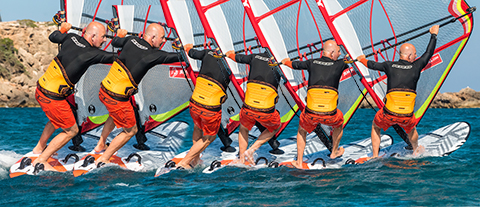
1. See the clew and carve through back foot as hips start shifting across.
2. Sail opens up and moves to the outside of the turn and your front foot twists out of the strap ready to shift across.
3. Heal meets toe as you keep seeing the clew and have the rig away to keep power in it.
4. New back foot is weighted as you keep low to enable new front foot to ’shift’ forward.
5. Keep pulling down on the boom here and seeing your exit and be ready for the clew first contact.
6. Your feet are set and are now ready to carve out of the gybe as you rotate the rig, after your clew first contact, which gives you time to slide your back hand towards the mast ready for a slick rig rotation.
Overall gybe tips
As it is spring time, let’s have a quick recap on the main gybe tips:
1. Back hand waaay down the boom.
2. Front hand back on the boom.
3. Always hang off the boom and keep pulling down on it when unhooked.
4. Back foot back and on the rail. The back foot can come out pre bear away (or during), but it must be back and next to the back strap.
5. Scissor/steer a flat board into the gybe. This means not carving till your board speed is up. The sail will lighten and the rails can thereby be carved smoothly.
6. Roll into the carve on an extended front arm. How we start, and carve, is how we end. Rig away at the start helps keep it that way mid gybe which helps lighten our feet!
7. Carve through gradually increasing back foot pressure, after setting the rail on your front foot.
8. Look out of the turn dead downwind, aiming to get the rig across and open. This helps weight our back foot to lighten our front foot.
9. Rig moves out as hips move in to the middle of the arc. This is an absolute must and sets up slick footwork, as our now light front foot can switch.”
10. Bent back leg in, bent back leg out. Keep low, and think plié, with the old front heel switching across to meet the old back toes as you SWITCH your feet, and then the new front foot steps forward. Bent ankles and knees mean you will pivot and be in a position to carve out.
11. Take some power clew first and keep looking out of the turn.
12. Rotate the rig and take it through a big circle. Take it way back and then drive it forwards all whilst looking forward.
13. ‘Get down James Brown’ – out, through and into the gybe!
14. ‘Where you look is where you go’ or more accurately where you look is where your hips go, which then shifts the weight over that foot, and assists smooth footwork.
Kit
Generous straps to allow feet to carve and both move in and out of the footstraps smoothly.
Long lines enable you to sail fast over bumpy water and facilitate easy unhooking from a low position.
On bigger boards ensure you are not ‘overfinned’ as this hinders carving both in and through the gybe.
Drills to improve footwork and gybe exits
• Tacks. What?? If you can tack then you are upwind and can practice more gybes. The footwork in the tack will also demand you to be pivoting on the balls of your feet and all while in a good counterbalance too! This then makes your gybe footwork better. Our steering out of the tack builds skills to scissor into a gybe.
• Light wind gybes. Steer / scissor in with nice wide hands and feet. Look, get low and rig away in the middle and get those hips across to the inside. Really focus on getting the old front foot across so that the heel meets the toes of the original foot. Sail out clew first and ensure your hips stay out and back. Then exaggerate your rig rotation by being low and looking forward throughout. More on the exit later in the year!
• Clew first beach starts. Get into position and come up onto the board clew first, and then rotate the rig. This will ensure you know how to weight your back foot, crucial for a clean get away after slick footwork. And it will build your steering and power control clew first. Remember your key principles: look, low and away.
Light wind drills really give you the chance to feel your footwork and repeat it many times and all at slower speeds in more manageable conditions. These drills will fully build your skill set!
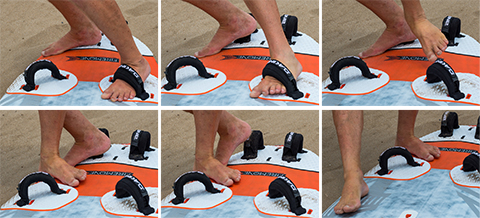
1.Carving in with bent ankle and back foot back, touching back strap and on the rail.
2. Hips swinging to the inside of the turn weights the back foot so the front foot can twist and shift.
3. Back carving leg stays bent as old front foot shifts across so the heal can meet the toes off the back foot.
4. New back foot has shifted all the way across to the rail to keep the board carving.
5. Weight the new back foot so the new front foot can shift and reach forward. Pulling down on the boom throughout keeps more weight on the rig and off your feet!
6. Weight is over the back foot so you can take some power in the clew first contact position. The carving exit and rig rotation comes next.
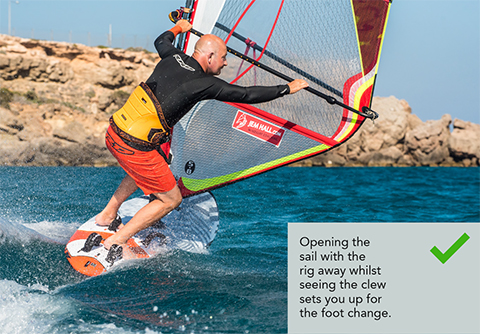
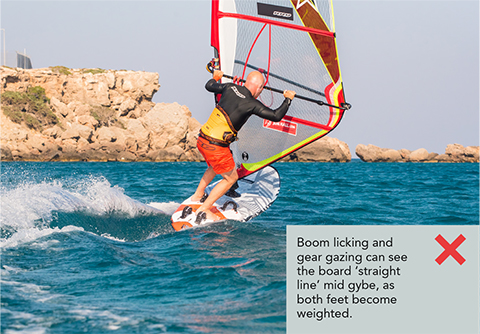
Top tips for fast smooth footwork
The main principle here is counterbalance, this means your hips moving in the opposite direction to the rig. In the gybe this means the rig moves to the outside, mid gybe, so your hips can move to the inside, and this then weights your back foot so you can actually get your front foot across in the foot change.
Here are some more precise nuggets of information.
• Ensure you are opening the sail mid gybe, dead downwind, as this keeps the power in it and begins its movement to the outside of the turn.
• Increase your back foot pressure mid gybe so the board keeps turning as you are doing your foot change. Seeing the clew assists this hugely.
• Fully ensure your back foot is back and as close to the rail as possible. We all mess this up and it makes a huge difference, especially on bigger boards.
• Pulling down on the boom a lot lightens your front foot so it can come out of the strap. At this phase I think ‘drop’ (bodyweight) and ‘extend’ (arms).
• See the clew and I mean really see it.
• Twisting the front foot and switching it across to the carving rail ensures the carve keeps going. Think heel meets toe.
• Let the sail breathe by keeping your mast arm open and this will give you the power to hang off the rig and keep your weight on your new back foot.
• As the front foot ‘reaches’ forward your hips stay back to anticipate the clew first power (contact) that is coming.
• The new front foot should land on the upwind rail and face forward.
• For lighter winds step further forward in order to flatten the board to help keep it moving for a faster exit.
• For stronger winds, and with more exit speed, you do not need to step as far forward as you already have more speed and power and you need to be further back to deal with the power you will face after collecting the rig.
I cannot urge you enough to get this footwork right, either on dry land on your board, or in light winds – eat, sleep, gybe, repeat!
Conditions
Flatter water, or patches of water, so the board is stable for easier foot changes.
Medium powered to get sail light and yet be in control for the foot change.
RRD boards, wetsuits & soft wear, Ezzy Sails & Black Project fins sponsor Jem Hall. Get him live and direct on one of his highly acclaimed coaching holidays but be quick as they are selling out – check out his fab new site www.jemhall.com for details. You can also follow him on twitter/Facebook/Instagram.
www.jemhall.com
